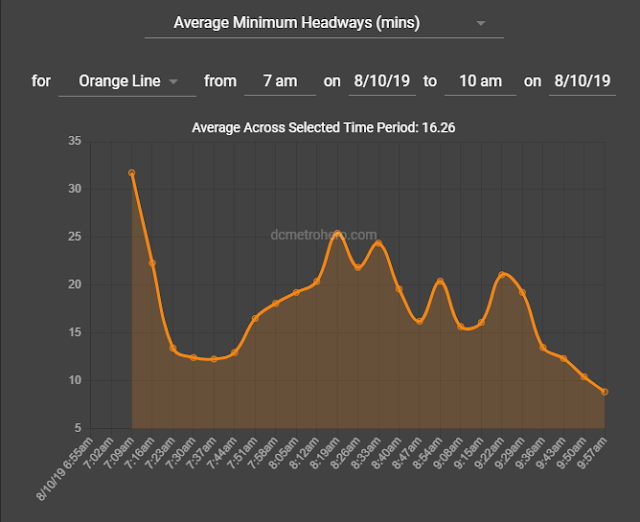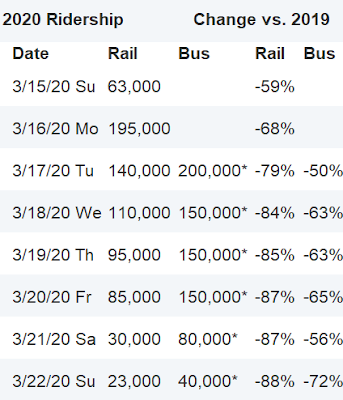Overnight signal damage causes single-tracking on Orange, Silver, Blue lines
Damage to Metro signaling equipment caused three hours of single-tracking on the Orange, Silver and Blue lines on Saturday morning, August 10. The delay, officially reported as a "signal problem," stemmed from a work unit being used during overnight trackwork that caused damage which required repairs.
Metro's safety department inspected the scene to perform investigatory work and released the scene at 4:45am to allow for repairs to take place. A second track unit, prime mover PM43, was used in the area to help make repairs.
While work to restore the signal was ongoing, Orange, Silver, and Blue line trains shared tracks between Stadium-Armory and Cheverly and Stadium-Armory and Addison Road. Orange Line trains came least frequently at around 8:20am, when the average minimum headway was over 25 minutes when 12 minutes between trains would be expected.
The affected signal which Metro crews repaired through the morning is identified as D98/42, the signal which governs train traffic at the convergence of the westbound tracks coming from Minnesota Ave and Benning Rd. Work to repair the signal and signaling system began at approximately 6:45am after work in an adjacent area of track finished, after crews were able to re-verify that all power in the area was down as required, and after paperwork was handled to set up the new emergency trackwork area with a new set of track rights.
While work to repair the westbound signal was ongoing, the WMATA ROCC was intermittently unable to establish routes for eastbound train traffic, meaning Automatic Train Control (ATC) engineers had to manually crank and clamp switches in the area to set them in the right position so they wouldn't move when a train passed overtop. Being unable to set routes also meant that trains were not receiving "speed commands" instructing the train software of the maximum allowable speed in the single-tracking area.
Since the ROCC was sometimes unable to set routes, some trains had to be moved under "absolute block" where the ROCC is able to give verbal permission for trains to move in absence of a functioning ATC system (in this case, when trains were moving against the flow of traffic set in the single-tracking area). This limited train speeds to 15 miles per hour and lengthened the time single-tracking took.
Normal traffic was restored at 9:43am when single-tracking ended. Both a Silver and an Orange Line train performed track inspections on the inbound tracks when they reopened which ended the event.
The incident occurred at approximately 3:35am on Saturday, August 10 when it appears indications in the Rail Operations Control Center (ROCC) alerted controllers that something had caused a signal or signals outside Stadium-Armory in the "D&G junction" to malfunction. Based on audio recordings of the incident, it appears that a trackwork unit, SM03, was the closest of two units in the area at the time of the incident, and likely the one which caused damage to the signaling equipment.Actually this wasn’t a software malfunction, a prime mover collided with a signal or signals at D98 around 3:30am.— M (@TunnelRatDC) August 10, 2019
Metro's safety department inspected the scene to perform investigatory work and released the scene at 4:45am to allow for repairs to take place. A second track unit, prime mover PM43, was used in the area to help make repairs.
While work to restore the signal was ongoing, Orange, Silver, and Blue line trains shared tracks between Stadium-Armory and Cheverly and Stadium-Armory and Addison Road. Orange Line trains came least frequently at around 8:20am, when the average minimum headway was over 25 minutes when 12 minutes between trains would be expected.
 |
| Headways on the Orange Line on Saturday during single-tracking. Chart from DC MetroHero. |
The affected signal which Metro crews repaired through the morning is identified as D98/42, the signal which governs train traffic at the convergence of the westbound tracks coming from Minnesota Ave and Benning Rd. Work to repair the signal and signaling system began at approximately 6:45am after work in an adjacent area of track finished, after crews were able to re-verify that all power in the area was down as required, and after paperwork was handled to set up the new emergency trackwork area with a new set of track rights.
While work to repair the westbound signal was ongoing, the WMATA ROCC was intermittently unable to establish routes for eastbound train traffic, meaning Automatic Train Control (ATC) engineers had to manually crank and clamp switches in the area to set them in the right position so they wouldn't move when a train passed overtop. Being unable to set routes also meant that trains were not receiving "speed commands" instructing the train software of the maximum allowable speed in the single-tracking area.
Since the ROCC was sometimes unable to set routes, some trains had to be moved under "absolute block" where the ROCC is able to give verbal permission for trains to move in absence of a functioning ATC system (in this case, when trains were moving against the flow of traffic set in the single-tracking area). This limited train speeds to 15 miles per hour and lengthened the time single-tracking took.
Normal traffic was restored at 9:43am when single-tracking ended. Both a Silver and an Orange Line train performed track inspections on the inbound tracks when they reopened which ended the event.

